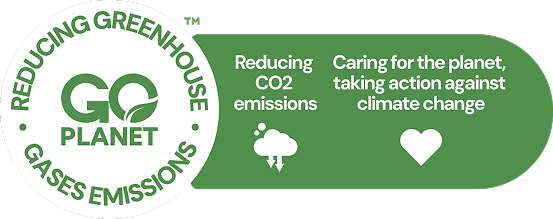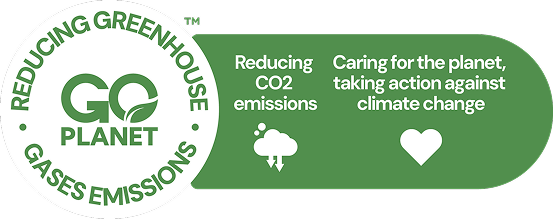
CONTACT
Do you have any questions or need more information?
Reach out to our experts! Complete the fields below to receive detailed information and join this movement.



Thank you for reaching out.
Our team will contact you as soon as possible to address your questions.

FREQUENTLY ASKED QUESTIONS
Find answers to your most important questions about the seal.
1. Why choose foods with reduced GHG emissions in their production process?
Choosing foods produced with reduced greenhouse gas (GHG) emissions is a powerful way to support a movement dedicated to caring for the planet. The rise in GHG emissions has led to global warming, posing significant risks to environmental balance. By opting for foods that incorporate solutions to lower these emissions, we actively contribute to building a more sustainable future.
2. How do GO PLANET™ certified products help reduce greenhouse gas emissions?
GO PLANET™ certified products leverage various practices and technologies to minimize GHG emissions in livestock farming. One key approach is the use of nutritional additives in cattle feed, which significantly reduce methane emissions—a major contributor to global warming. By choosing dairy products or beef produced with these innovative supplements, you are supporting products with a lower environmental impact during the farming process.
3. Why should farms using methane-reducing additives be certified?
PFor methane-reducing additives to be effective, specific guidelines must be followed, including proper inclusion in the animals’ diet, correct dosage, and adherence to good nutritional practices on the farm. The certification process ensures compliance with these rules through rigorous audits. It also verifies that the industries processing and packaging milk and meat with the GO PLANET™ seal are audited, guaranteeing product origin and traceability. As a result, milk and meat bearing the GO PLANET™ seal come from certified farms committed to reducing greenhouse gas emissions.
4. How does the certification process work?
The certification process involves auditing both the farms where animal products originate and the industries where they are processed and packaged.
To begin certification, the farm prepares a management plan to supplement the herd with a methane-reducing additive. After 30 days, the farm schedules an audit to verify processes, documentation, and compliance with the program’s guidelines. Milk or animals for slaughter must be sent to a certified industry to qualify for the GO PLANET™ seal.
The industry must source raw materials exclusively from certified suppliers and develop a logistics and processing plan aligned with the program’s requirements. Once the industry begins receiving and processing raw materials from certified farms, it can schedule an audit to validate its adherence to the program’s standards.
5. What is carbon dioxide (CO₂), and what does a product’s carbon footprint mean?
Carbon is a fundamental chemical element essential for life on Earth, found in all forms of organic matter. Carbon dioxide (CO₂) is a molecule made up of two oxygen atoms and one carbon atom. It is one of the primary greenhouse gases contributing to global warming. A product’s carbon footprint represents the total greenhouse gas emissions generated during its production, transportation, and use. These emissions are calculated by converting them into carbon dioxide equivalents. The carbon footprint serves as a critical environmental metric, helping to identify sources of emissions and providing insights into how they can be reduced.
6. Why is reducing methane emissions important?
Methane is a powerful greenhouse gas that plays a significant role in global warming. According to Intergovernmental Panel on Climate Change (IPCC) data, methane was the second-largest contributor to global warming over the past 20 years*, second only to CO₂.
Unlike CO₂, methane has a much higher warming potential but a shorter lifespan in the atmosphere. This means that reducing methane emissions can yield faster improvements in the fight against global warming.
This urgency has led many countries and companies to prioritize methane reduction. For instance, the Global Methane Pledge—a global initiative led by the United States and the European Union and signed by 150 countries—aims to reduce methane emissions by at least 30% by 2030. The pledge focuses on key areas such as the energy sector, agriculture, waste management, and oil and gas production.
* Source: IPCC 2021, The Physical Science Basis. Contribution of Working Group I to the Sixth Assessment Report of the Intergovernmental Panel on Climate Change [Masson-Delmotte, V., P. Zhai, A. Pirani, S. L. Connors, C. Péan, S. Berger, N. Caud, Y. Chen, L. Goldfarb, M. I. Gomis, M. Huang, K. Leitzell, E. Lonnoy, J. B. R. Matthews, T. K. Maycock, T. Waterfield, O. Yelekçi, R. Yu y B. Zhou (editores)]. Cambridge University Press
7. What is conscious livestock farming?
Conscious livestock farming is an animal production model focused on minimizing the environmental impact of meat and milk production while supporting rural producers and ensuring high-quality products for consumers.
Key practices in conscious livestock farming include:
· Reducing Greenhouse Gas Emissions: Utilizing technologies that minimize methane emissions from livestock.
· Promoting Animal Welfare: Ensuring animals are raised with comfort, dignity, and in environments that meet their natural needs for healthy development.
· Responsible Use of Natural Resources: Managing water and energy efficiently to reduce waste and conserve these vital resources.
· Efficient Pasture Management: Adopting strategies that maximize land use efficiency, prevent deforestation and soil degradation, and use soil as a carbon storage solution.

